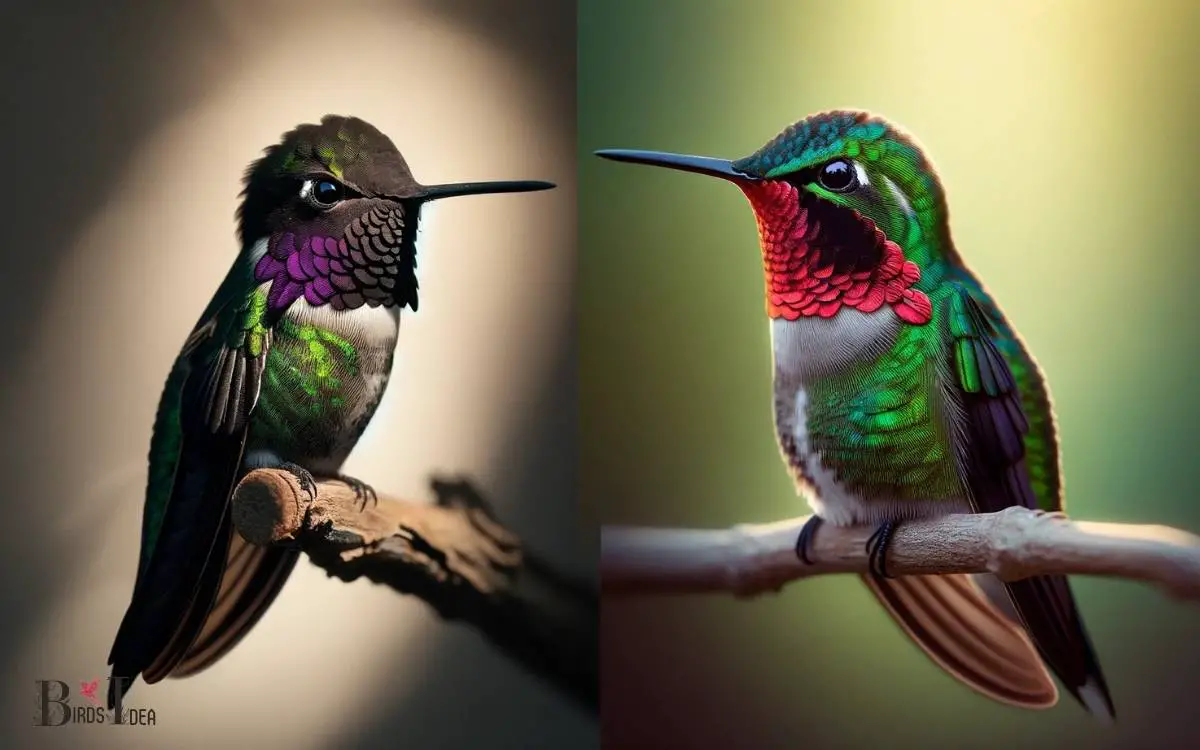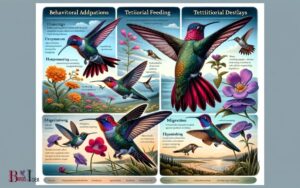Black Chinned Hummingbird Vs Ruby Throated Hummingbird
The Black-chinned Hummingbird (Archilochus alexandri) and the Ruby-throated Hummingbird (Archilochus colubris) are two distinct species of hummingbirds found in the Americas.
The Black-chinned Hummingbird has a black, shimmering throat with a purple edge, which is noticeable in good lighting. In contrast, the Ruby-throated Hummingbird boasts a vivid, iridescent red throat.
Both species exhibit sexual dimorphism, with males having more prominent throat colors than females. The Black-chinned prefers the western U.S., while the Ruby-throated is more common in the east.
When comparing the Black-chinned Hummingbird to the Ruby-throated Hummingbird, several factors stand out:
A short example of their differences can be seen during the breeding season, where the Black-chinned Hummingbird will establish its territory in the western regions and the Ruby-throated in the east, rarely overlapping.

Key Takeaway
Physical Characteristics
When comparing the physical characteristics of the Black Chinned Hummingbird and the Ruby Throated Hummingbird, it becomes evident that they exhibit distinct differences in size, coloration, and plumage patterns.
The Black Chinned Hummingbird is slightly larger, with a length of about 3.5 inches and a wingspan of approximately 4.3 inches, while the Ruby Throated Hummingbird measures around 3-3.5 inches in length with a wingspan of 4-4.5 inches.
In terms of coloration, the Black Chinned Hummingbird has a black chin patch, a metallic green back, and a white breast, whereas the Ruby Throated Hummingbird showcases a vibrant ruby-red throat patch on males and a white throat on females.
Additionally, the plumage patterns of these species differ, with the Black Chinned Hummingbird displaying subtle but distinct plumage markings on its throat and belly, while the Ruby Throated Hummingbird possesses more pronounced and contrasting plumage patterns.
Feeding Behavior
The feeding behavior of the Black Chinned Hummingbird and the Ruby Throated Hummingbird varies significantly in their foraging strategies and dietary preferences.
Foraging Strategies:
- The Black Chinned Hummingbird tends to feed on nectar from a variety of flowers, favoring tubular-shaped blooms, and also consumes small insects and spiders as a source of protein.
- In contrast, the Ruby Throated Hummingbird primarily feeds on nectar from red or orange tubular flowers and is known to catch insects in mid-air as part of its foraging behavior.
Dietary Preferences:
- The Black Chinned Hummingbird has a more diverse diet, including a wider range of flower types and insects.
- The Ruby Throated Hummingbird, while also consuming nectar from flowers, shows a greater preference for specific flower colors and is more reliant on catching insects for protein.
Range and Habitat
The range and habitat of the Black Chinned Hummingbird and the Ruby Throated Hummingbird are influenced by their distinct foraging behaviors and dietary preferences.
The Black Chinned Hummingbird is primarily found in the western United States and Mexico, preferring arid scrublands, canyons, and mountain meadows up to 10,000 feet.
In contrast, the Ruby Throated Hummingbird is commonly found in eastern North America, from Canada to the Gulf of Mexico, favoring open woodlands, gardens, and meadows.
To better understand their range and habitat preferences, refer to the table below:
| Hummingbird Species | Range | Habitat |
|---|---|---|
| Black Chinned Hummingbird | Western United States, Mexico | Arid scrublands, canyons, mountain meadows |
| Ruby Throated Hummingbird | Eastern North America | Open woodlands, gardens, meadows |
Understanding their distinct ranges and habitats provides insight into their behavior and ecological requirements. This knowledge contributes to a comprehensive understanding of their overall ecology and conservation needs, including mating and nesting behaviors.
Mating and Nesting
In both the Black Chinned Hummingbird and the Ruby Throated Hummingbird, mating and nesting behaviors are intricately linked to their specific environmental requirements and social dynamics.
- Breeding Season: The Black Chinned Hummingbird breeds from late spring to early summer, while the Ruby Throated Hummingbird breeds from late spring to mid-summer.
- Nest Construction: Both species build remarkable cup-shaped nests using materials such as plant down, spider silk, and lichens, with the Black Chinned Hummingbird often incorporating feathers and the Ruby Throated Hummingbird preferring moss.
- Clutch Size: The Black Chinned Hummingbird typically lays 2 eggs per clutch, whereas the Ruby Throated Hummingbird may lay 1-3 eggs per clutch.
- Incubation Period: Incubation lasts about 16-18 days for the Black Chinned Hummingbird and 12-14 days for the Ruby Throated Hummingbird.
These differences in mating and nesting behaviors reflect the unique adaptations of each species to their respective habitats and ecological niches.
Migration Patterns
During migration, the Black Chinned Hummingbird and the Ruby Throated Hummingbird follow distinct routes to reach their wintering grounds.
The Black Chinned Hummingbird migrates from the western United States to Mexico, with some populations traveling as far south as Central America.
In contrast, the Ruby Throated Hummingbird travels from eastern North America to Central America, covering a distance of approximately 500 miles across the Gulf of Mexico.
Both species time their migration to coincide with the blooming of flowers, ensuring an abundant nectar supply along their routes.
The Black Chinned Hummingbird’s migration usually begins earlier in the fall, while the Ruby Throated Hummingbird typically starts its journey later. Understanding these migration patterns is crucial for the conservation of these species, as it allows conservationists to protect critical stopover sites and wintering habitats.
In the subsequent section, we will explore the conservation status of the Black Chinned Hummingbird and the Ruby Throated Hummingbird.
Conservation Status
The conservation status of the Black Chinned Hummingbird and Ruby Throated Hummingbird is of critical concern due to various threats to their habitats, resulting in population decline concerns.
Both species face challenges such as habitat loss, climate change, and potential competition for resources. Conservation efforts are needed to address these threats and ensure the survival of these exquisite hummingbird species.
Threats to Habitats
Habitat threats pose a significant challenge to the conservation status of both the Black Chinned Hummingbird and the Ruby Throated Hummingbird. These threats can significantly impact their populations and overall well-being.
The following are the primary threats to the habitats of these hummingbird species:
- Deforestation: Large-scale clearing of forests for agriculture, urbanization, and logging destroys the natural habitats essential for these hummingbirds.
- Climate Change: Shifts in temperature and precipitation patterns can disrupt the availability of nectar-bearing flowers, affecting the hummingbirds’ food sources.
- Pollution: Contamination of air, water, and soil from human activities can directly and indirectly harm hummingbirds and their habitats.
- Invasive Species: Non-native plants and animals can outcompete native flora and fauna, altering the ecosystems upon which these hummingbirds depend.
Efforts to mitigate these threats are crucial for the long-term conservation of these magnificent birds.
Population Decline Concerns
Amid growing concerns about population decline and conservation status, it is imperative to assess the current status of the Black Chinned Hummingbird and the Ruby Throated Hummingbird.
The Black Chinned Hummingbird faces threats such as habitat loss due to urbanization and climate change.
Its population decline is of concern, and it is currently categorized as a species of Least Concern on the IUCN Red List. In contrast, the Ruby Throated Hummingbird is facing similar challenges, including habitat loss and climate change impacts.
Its population decline is also worrisome, and it is categorized as a species of Least Concern. However, these classifications do not negate the need for conservation efforts to protect their habitats and ensure their survival.
Conservation Efforts Needed
To address the conservation status of the Black Chinned Hummingbird and the Ruby Throated Hummingbird, targeted measures must be implemented to safeguard their habitats and ensure their survival.
Conservation efforts are crucial to mitigate the threats these species face and prevent further population decline.
The following steps are essential to improve the conservation status of these hummingbirds:
- Habitat Protection: Establish protected areas and reserves to conserve critical habitats for both species.
- Nesting Site Preservation: Identify and protect nesting sites to ensure successful breeding and population growth.
- Threat Mitigation: Implement measures to reduce threats such as habitat loss, climate change, and pesticide use.
- Public Awareness: Educate the public about the importance of these hummingbirds and promote conservation efforts to garner support and involvement.
Conclusion
The black-chinned and ruby-throated hummingbirds exhibit remarkable differences in physical characteristics, feeding behavior, range and habitat, mating and nesting, migration patterns, and conservation status.
Despite these differences, both species symbolize the delicate balance and beauty of nature. Their presence serves as a reminder of the interconnectedness of all living things and the importance of preserving their habitats for future generations to appreciate and enjoy.






